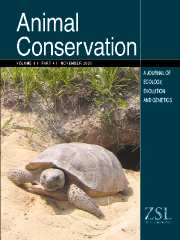Crossref Citations
This article has been cited by the following publications. This list is generated based on data provided by
Crossref.
Wyner, Yael M.
Amato, George
and
DeSalle, Rob
1999.
Captive breeding, reintroduction, and the conservation genetics of black and white ruffed lemurs, Varecia variegata variegata.
Molecular Ecology,
Vol. 8,
Issue. s1,
Amato, George
Egan, Mary G.
and
Rabinowitz, Alan
1999.
A new species of muntjac, Muntiacus putaoensis (Artiodactyla: Cervidae) from northern Myanmar.
Animal Conservation,
Vol. 2,
Issue. 1,
p.
1.
Kitchener, Andrew C.
and
Dugmore, Andrew J.
2000.
Biogeographical change in the tiger, Panthera tigris.
Animal Conservation,
Vol. 3,
Issue. 2,
p.
113.
Hendrickson, Sher L.
Mayer, Gregory C.
Wallen, Edward P.
and
Quigley, Kathy
2000.
Genetic variability and geographic structure of three subspecies of tigers (Panthera tigris) based on MHC class I variation.
Animal Conservation,
Vol. 3,
Issue. 2,
p.
135.
2000.
The Conservation Handbook.
p.
252.
Sinclair, Elizabeth A.
Pérez-Losada, Marcos
and
Crandall, Keith A.
2001.
Phylogeny and Conservation.
p.
19.
Wetton, Jon H.
Tsang, Carol S.F.
Roney, Chris A.
and
Spriggs, Adrian C.
2002.
An extremely sensitive species-specific ARMS PCR test for the presence of tiger bone DNA.
Forensic Science International,
Vol. 126,
Issue. 2,
p.
137.
Sarmiento, Esteban E.
2002.
Gorilla Biology.
p.
432.
Gaubert, Philippe
and
Veron, Géraldine
2003.
Exhaustive sample set among Viverridae reveals the sister-group of felids: the linsangs as a case of extreme morphological convergence within Feliformia.
Proceedings of the Royal Society of London. Series B: Biological Sciences,
Vol. 270,
Issue. 1532,
p.
2523.
Russello, Michael A.
Gladyshev, Eugene
Miquelle, Dale
and
Caccone, Adalgisa
2004.
Potential genetic consequences of a recent bottleneck in the Amur tiger of.
Conservation Genetics,
Vol. 5,
Issue. 5,
p.
707.
Meijaard, Erik
2004.
BIOGEOGRAPHIC HISTORY OF THE JAVAN LEOPARD PANTHERA PARDUS BASED ON A CRANIOMETRIC ANALYSIS.
Journal of Mammalogy,
Vol. 85,
Issue. 2,
p.
302.
Agapow, Paul‐Michael
Bininda‐Emonds, Olaf R P
Crandall, Keith A
Gittleman, John L
Mace, Georgina M
Marshall, Jonathon C
and
Purvis, Andy
2004.
The Impact of Species Concept on Biodiversity Studies.
The Quarterly Review of Biology,
Vol. 79,
Issue. 2,
p.
161.
Godfray, H. C. J.
Knapp, S.
and
Mace, Georgina M.
2004.
The role of taxonomy in species conservation.
Philosophical Transactions of the Royal Society of London. Series B: Biological Sciences,
Vol. 359,
Issue. 1444,
p.
711.
Luo, Shu-Jin
Kim, Jae-Heup
Johnson, Warren E
Walt, Joelle van der
Martenson, Janice
Yuhki, Naoya
Miquelle, Dale G
Uphyrkina, Olga
Goodrich, John M
Quigley, Howard B
Tilson, Ronald
Brady, Gerald
Martelli, Paolo
Subramaniam, Vellayan
McDougal, Charles
Hean, Sun
Huang, Shi-Qiang
Pan, Wenshi
Karanth, Ullas K
Sunquist, Melvin
Smith, James L. D
O'Brien, Stephen J
and
Craig Moritz
2004.
Phylogeography and Genetic Ancestry of Tigers (Panthera tigris).
PLoS Biology,
Vol. 2,
Issue. 12,
p.
e442.
Veron, Géraldine
Colyn, Marc
Dunham, Amy E
Taylor, Peter
and
Gaubert, Philippe
2004.
Molecular systematics and origin of sociality in mongooses (Herpestidae, Carnivora).
Molecular Phylogenetics and Evolution,
Vol. 30,
Issue. 3,
p.
582.
Wetton, Jon H.
Tsang, Carol S.F.
Roney, Chris A.
and
Spriggs, Adrian C.
2004.
An extremely sensitive species-specific ARMs PCR test for the presence of tiger bone DNA.
Forensic Science International,
Vol. 140,
Issue. 1,
p.
139.
Palkovacs, Eric P.
Oppenheimer, Adam J.
Gladyshev, Eugene
Toepfer, John E.
Amato, George
Chase, Thomas
and
Caccone, Adalgisa
2004.
Genetic evaluation of a proposed introduction: the case of the greater prairie chicken and the extinct heath hen.
Molecular Ecology,
Vol. 13,
Issue. 7,
p.
1759.
Wei, Kun
Zhang, Zhi‐He
Zhang, Wen‐Ping
Shen, Fu‐Jun
He, Guang‐Xin
Hou, Rong
Xie, Zhong
Liu, Nong‐Lin
and
Yue, Bi‐Song
2005.
Sequence variation of mitochondrial DNA ND5 in captive South China tigers (Panthera tigris amoyensis).
Journal of Natural History,
Vol. 39,
Issue. 46,
p.
3979.
IYENGAR, A.
BABU, V. N.
HEDGES, S.
VENKATARAMAN, A. B.
MACLEAN, N.
and
MORIN, P. A.
2005.
Phylogeography, genetic structure, and diversity in the dhole (Cuon alpinus).
Molecular Ecology,
Vol. 14,
Issue. 8,
p.
2281.
Dubach, Jean
Patterson, B. D.
Briggs, M. B.
Venzke, K.
Flamand, J.
Stander, P.
Scheepers, L.
and
Kays, R. W.
2005.
Molecular genetic variation across the southern and eastern geographic ranges of the African lion, Panthera leo.
Conservation Genetics,
Vol. 6,
Issue. 1,
p.
15.


